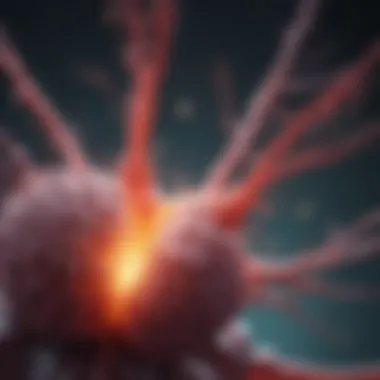Lung Cancer and Hypoxia: Understanding the Connection


Intro
Lung cancer ranks among the leading causes of cancer-related deaths globally. The relationship between lung cancer and low oxygen levels, often referred to as hypoxia, adds a layer of complexity to understanding this disease. Hypoxia occurs when there isn’t enough oxygen in the tissues, which can influence tumor behavior and resilience against therapies. By examining this connection, we can better understand the mechanisms at play, paving the way for more effective treatment strategies that may improve patient outcomes.
Research Overview
Summary of Key Findings
In exploring lung cancer and its association with low oxygen levels, several crucial insights emerge:
- Tumor Microenvironment: Low oxygen conditions enable tumor cells to adapt, leading to increased aggression and metastasis.
- Treatment Resistance: Hypoxia has been linked to resistance against standard therapies, affecting their efficacy and success rates.
- Biomarkers: Certain biomarkers associated with hypoxia may help predict outcomes, guiding more personalized treatment approaches.
Background and Context
The concept of hypoxia affecting cancer progression isn't new. Researchers have been investigating how varying oxygen levels in the tumor microenvironment play a fundamental role in tumor growth. Tumors can create their own blood supply, a process called angiogenesis, as they outgrow existing vessels, contributing to low oxygen conditions. Understanding how these environments affect lung cancer cells can reveal new avenues for intervention.
Methodology
Experimental Design
Research in the field typically employs a blend of laboratory experiments and clinical studies to assess how hypoxia affects lung cancer cells. In vitro studies using cell lines cultured in low oxygen conditions help in understanding basic cellular behaviors. Furthermore, in vivo studies on animal models allow researchers to observe tumor development and treatment responses within a living organism.
Data Collection Techniques
Data in these studies often come from:
- Cell proliferation assays: Measuring how quickly cells grow under different oxygen conditions.
- Gene expression profiling: Analyzing how hypoxia alters the activity of genes linked to cancer progression.
- Patient data: Reviewing clinical outcomes related to therapy response in patients diagnosed with lung cancer and correlating these to hypoxic markers found in tumor samples.
"Understanding how low oxygen levels influence lung cancer is not just an academic exercise; it holds the key to improving the lives of millions battling this disease."
The better our grasp of the nuances of hypoxia in lung cancer, the closer we are to implementing strategies that could turn the tide against this relentless disease.
Understanding Lung Cancer
Lung cancer is a prominent health crisis globally. Understanding it is essential not only for medical professionals but for students and researchers who wish to unravel the complexities of this disease. This section lays the groundwork for it all. The relationship between lung cancer and low levels of oxygen—hypoxia—affects how tumors develop, progress, and respond to treatments. By grasping the nuances of lung cancer, one can appreciate the broader implications of hypoxia in patient management and therapeutic strategies.
Definition and Overview
Lung cancer is primarily classified as an uncontrolled growth of abnormal cells in one or both lungs. These cells can form tumors and impede vital functions of the respiratory system. The survival rates for lung cancer patients primarily hinge on the disease's stage, the tumor type, and the available treatment options. Addressing lung cancer's impact involves a thorough comprehension of its biological underpinnings and the broader environmental and physiological context surrounding it.
Types of Lung Cancer
Non-Small Cell Lung Cancer
Non-Small Cell Lung Cancer (NSCLC) accounts for approximately 85% of lung cancer cases. It is a broad category that includes several subtypes, namely adenocarcinoma, squamous cell carcinoma, and large cell carcinoma. A significant feature of NSCLC is that it generally grows and spreads more slowly than small cell lung cancer. This characteristic makes it a vital area of focus in understanding how low oxygen levels can influence tumor behavior and treatment outcomes. NSCLC's adaptability in low-oxygen environments presents unique challenges for medical intervention, as the presence of hypoxia often confers a survival advantage to the tumor cells.
Small Cell Lung Cancer
Small Cell Lung Cancer (SCLC) is less common, making up about 15% of lung cancer cases. Characterized by rapid growth and early spread, SCLC often presents an aggressive challenge due to its high sensitivity to chemotherapy. The critical aspect of SCLC in the context of hypoxia is its responsiveness to treatment, although the outcomes can be somber. In hypoxic conditions, SCLC can demonstrate both resilience and strategies to bypass therapy, warranting further exploration in treatment protocols specific to oxygen levels.
Rare Lung Cancers
Rare lung cancers, including carcinoid tumors and other rarer subtypes, make up a smaller percentage of lung cancer cases. These types are crucial as they demonstrate different biological behaviors and responses to oxygen levels compared to more common types. One unique feature of rare lung cancers is their generally better prognosis and slower growth rates. Understanding their physiology in relation to hypoxia might unveil holistic treatment strategies that could be leveraged for all lung cancer types.
Risk Factors for Lung Cancer
Smoking and Environmental Factors
Cigarette smoking is the largest contributor to lung cancer risk, with about 85% of cases being attributable to tobacco exposure. The environmental aspect cannot be overlooked, as pollutants and secondhand smoke also play significant roles. The crux of these factors lies in their ability to induce cellular damage, leading to abnormal growth in lung tissues. This cellular alteration becomes critical in the hypoxic context since such conditions can exacerbate tumor progression in genetically predisposed individuals or those already at risk due to environmental influences.


Genetic Predisposition
Certain individuals may possess genetic markers that predispose them to lung cancer, such as mutations in the EGFR gene. Understanding this genetic link can enable the identification of at-risk populations, which is vital for early intervention. The intersection between genetic predisposition and hypoxia is particularly interesting, as hypoxic conditions can further amplify the malignancy associated with these mutations.
Occupational Hazards
Occupational exposure to harmful substances, including asbestos, radon, and various industrial chemicals, represents an insidious risk factor for lung cancer. Workers in certain industries may find themselves at increased risk, making it essential to incorporate workplace conditions into risk assessments. You could say that recognizing these hazards is not just precautionary but a vital step in preventing the overlap of hypoxic conditions with occupationally induced lung cancer, potentially improving patient outcomes.
The Role of Oxygen in Cellular Function
Oxygen plays a pivotal role in sustaining life at the cellular level, fueling various essential processes that support human health. Its availability directly impacts how cells generate energy, maintain homeostasis, and perform their dedicated functions. In the context of lung cancer, understanding the intricacies of oxygen's role becomes crucial, especially when contemplating how low oxygen levels influence tumor behavior and therapeutic efficacy.
Oxygen as an Essential Element
Oxygen is not just another element; it is a vital component of cellular respiration, the biochemical process that allows cells to convert nutrients into energy. Without it, our cells would struggle, if not fail, to thrive. The presence of oxygen is so fundamental that many organisms, including humans, have evolved specifically to exploit aerobic processes for energy production. The absence of sufficient oxygen – a condition known as hypoxia – can profoundly alter cellular functions and compromise overall health.
"> Oxygen deprivation can switch cellular pathways into survival mode, leading to significant changes in cell behavior, particularly in cancer cells. This adaptability can provide not only challenges but also avenues for potential therapies."
Mechanisms of Oxygen Utilization
Understanding how cells utilize oxygen provides insights into their fundamental operations and adaptations, especially under hypoxic conditions.
Aerobic Respiration
Aerobic respiration is like a well-oiled machine driving cellular energy demands. In this process, glucose is efficiently transformed into adenosine triphosphate (ATP) in the presence of oxygen. One key characteristic of aerobic respiration is its high energy yield, generating up to 36 ATP molecules per glucose molecule.
However, the reliance on oxygen can become a double-edged sword. While it provides ample energy, if oxygen levels drop, cells must switch to less efficient forms of energy production, such as anaerobic respiration. This switch can lead to the accumulation of lactic acid, causing discomfort and impaired function. In the landscape of lung cancer, the reliance on aerobic respiration can create vulnerabilities that may be exploited in treatment.
Energy Production
In essence, the conversation about energy production in relation to oxygen is about efficiency. Cells that rely on aerobic metabolism enjoy a higher energy output compared to those that resort to anaerobic pathways. The uniqueness of aerobic energy production lies in its maximization of substrates like glucose and fatty acids to fuel cellular activities. Cancer cells, initially relying on aerobic methods, may adapt to low oxygen environments by engaging alternative metabolic pathways.
Yet, this metabolic flexibility can foster a survival advantage, making these cells resilient in the face of therapeutic interventions aimed at reducing tumor viability. The balance of power between energy production and tumor survival is at the heart of current research in effectively targeting lung cancer.
Cellular Metabolism
Cellular metabolism encompasses all biochemical reactions within a cell, and oxygen is intrinsic to many of these processes. It governs the catabolism of carbohydrates, fats, and proteins, enabling cells to produce energy for various functions from division to repair. The flexibility of cellular metabolism allows cells to adapt to changing environments, especially under hypoxic conditions.
While this adaptability can sustain cancer cells, it can also implicate challenges in treatment strategies. When faced with low oxygen, cancer cells might aggressively adapt their metabolism to survive but could also present unique metabolic signatures that could be exploited for therapeutic targets.
Consequences of Oxygen Deprivation
When oxygen levels dip, a cascade of cellular events kicks into motion, profoundly affecting cellular health and functionality. Hypoxia, or low oxygen, doesn't merely halt energy production; it instigates a chain reaction that can lead to dire consequences for the entire organism, particularly in cancer contexts.
Hypoxia and Cellular Stress
Hypoxia generates significant cellular stress, which can push cells into a precarious state, leading to the activation of various survival pathways. A primary characteristic of this cellular stress is the uncontrolled activation of stress response pathways, which aim to adapt to low oxygen availability. For cancer cells, the stress from hypoxia may confer survival and proliferative advantages.
Nevertheless, such stress is a double-edged sword. While it may enhance resistance to conventional therapies, the persistent cellular stress can lead to dysfunction over time, affecting normal cellular signaling and overall organ function.
Apoptosis
Apoptosis, or programmed cell death, can be influenced by oxygen levels. Hypoxia has been shown to disrupt the delicate balance that regulates cell death and survival. Under typical circumstances, the cellular machinery would trigger apoptosis in severely damaged cells, thereby preventing proliferation. However, in a hypoxic environment, this mechanism can be thwarted, leading to an unintended accumulation of dysfunctional or mutated cells.
Here, the disarmament of apoptotic pathways in the face of low oxygen becomes relevant, as it shows how lung cancer cells can leverage these survival tactics to evade traditional treatments.
Impaired Functioning of Organs
The implications of impaired oxygen delivery extend far beyond cancer cells; it reverberates throughout the body, leading to systemic dysfunction. Organs rely on an adequate oxygen supply to perform optimally. Conditions like hypoxic injury arise when oxygen levels become insufficient, resulting in compromised organ functioning.
The intertwined relationship between hypoxic states and organ performance emphasizes the complexity of understanding lung cancer in the broader context of patient health. For instance, impaired lung function due to cancer progression coupled with hypoxia can greatly reduce the quality of life and hinder treatment options.


Summary
In summary, oxygen emerges as a crucial player in cellular function, with its scarcity heralding dire consequences. By delving into the multifaceted roles oxygen plays—from energy production to cellular metabolism, and through the cascade of reactions triggered by its deprivation—one can appreciate its centrality to understanding lung cancer dynamics. As research continues, grasping these concepts may lead to innovative treatment strategies that recognize the delicate balance between oxygen levels and tumor health.
Hypoxia in Lung Cancer
Hypoxia, a condition characterized by insufficient oxygen levels, plays a pivotal role when discussing lung cancer. Understanding hypoxia is critical as it affects tumor biology and patient outcomes profoundly. Low oxygen levels within the tumor microenvironment are not mere anomalies; rather, they are a significant contributor to tumor progression and treatment resistance. As tumors grow, the surrounding tissues can become increasingly hypoxic due to factors such as rapid cell proliferation, which outstrips blood supply. This begs the question of how lung cancer cells adapt and thrive despite such conditions. The complexities surrounding hypoxia hold great significance for therapeutic strategies, making it an essential point of study for clinicians and researchers alike.
Definition and Mechanisms of Hypoxia
Hypoxia denotes a state of reduced oxygen availability in tissues, which can arise from various causes such as inadequate vascularization or high altitudes. In the context of lung cancer, hypoxia is a considerable problem. Tumor cells can face harsh conditions that lead to cellular distress. The body responds via several mechanisms. For instance, cells under hypoxic stress may activate certain genes that promote survival, reshaping their environment to enhance oxygen delivery. This interplay of biology underscores both the challenges and adaptability seen in cancerous tissues.
Adaptations of Cancer Cells to Low Oxygen Levels
Metabolic Shift
The metabolic shift is a hallmark adaptive mechanism employed by cancer cells facing decreased oxygen. Under normal circumstances, cells primarily rely on aerobic respiration for energy, which requires oxygen. However, when oxygen is scarce, lung cancer cells often shift towards anaerobic glycolysis—a process that generates energy without oxygen. This adaptation is significant as it enables them to survive and grow despite unfavorable conditions. The key characteristic of this metabolic shift is its ability to sustain energy production when conventional methods falter. It's an attractive feature in the discussion of lung cancer, as it highlights how cancer cells exploit their environment for survival. However, this strategy also has drawbacks, as anaerobic metabolism leads to the accumulation of lactic acid, potentially causing further cellular stress.
Angiogenesis
Angiogenesis is another crucial adaptation seen in hypoxic tumor environments. This process involves the formation of new blood vessels, which helps increase oxygen and nutrient supply to the tumorous tissue. Cancer cells might secrete specific growth factors that promote this vascular development, enhancing their own survival. The key characteristic of angiogenesis is its effectiveness in circumventing oxygen deficiency, making it a significant player in tumor progression. The unique feature here is that while angiogenesis can facilitate growth, it can also lead to chaotic blood vessel structures, which might not efficiently supply oxygen, presenting both risks and rewards in treatment strategies.
Cell Proliferation and Survival
The ability of cancer cells to proliferate and survive is notably enhanced in hypoxic conditions. Cells can develop resistance to traditional treatments, making them more difficult to eradicate. This characteristic makes them particularly insidious in the pursuit of treatment. While survival in a low-oxygen environment may seem beneficial for cancer cells, it creates a complex scenario for medical professionals. The advantage lies in their effective evasion of apoptosis, the programmed cell death essential for normal cells. However, this resilience often leads to more aggressive cancer phenotypes, complicating treatment options.
Impact on Tumor Growth and Metastasis
Enhanced Tumorigenesis
Hypoxia contributes significantly to enhanced tumorigenesis, the process by which benign cells transform into malignant tumors. Under conditions of low oxygen, factors such as hypoxia-inducible factors (HIFs) can become activated, stimulating genetic expressions that promote tumor growth. The key characteristic of enhanced tumorigenesis is its reliance on hypoxia for acceleration. This discussion of tumorigenesis in the context of lung cancer emphasizes how vital oxygen levels are; low levels can directly correlate with rapid tumor development, shedding light on the necessity of addressing hypoxia in treatment approaches.
Increased Invasiveness
Increased invasiveness is another detrimental effect of hypoxia in lung cancer. Cells exposed to low oxygen levels often exhibit a heightened ability to invade surrounding tissues, leading to metastasis—the spread of cancer to other parts of the body. The unique feature of this invasion is that it is often coupled with changes in cell adhesion properties, allowing cancer cells to detach easily and migrate. This aspect is critical in understanding treatment resistance, as metastasis complicates patient management and recovery efforts.
Potential for Metastatic Spread
The potential for metastatic spread is significantly influenced by hypoxia. Cancer cells in low-oxygen environments can adapt to survive in various tissues, making it easier to establish new tumors. The flexibility of these cells is a major concern, as their ability to thrive beyond the primary site can lead to widespread disease. By exploring this potential, healthcare professionals can better design interventions aimed at reducing metastasis—the primary cause of cancer mortality. This highlights how a thorough grasp of hypoxia can be invaluable in shaping future treatment pathways, ultimately aiming to reduce the prevalence of advanced lung cancer cases.
Clinical Implications of Hypoxia in Lung Cancer
Understanding the clinical implications of hypoxia in lung cancer is crucial for improving treatment outcomes. Inadequate oxygen levels within tumors can lead to aggressive growth and treatment resistance, directly influencing survival rates. This section explores how hypoxia affects diagnostic methods and therapeutic strategies, emphasizing the importance of tailored approaches for lung cancer patients.
Hypoxia-Related Biomarkers
Hypoxia-Inducible Factors (HIFs)
Hypoxia-inducible factors, or HIFs, are proteins that play a critical role in how cells respond to low oxygen levels. When oxygen is scarce, HIFs activate genes that help the cancer cells adapt and survive. This makes HIFs particularly relevant in lung cancer research. They are often the focus when developing targeted therapies aimed at reducing tumor survival.
A key characteristic of HIFs is their ability to promote angiogenesis, which is the formation of new blood vessels. This process helps tumors secure the nutrients they need, even in low oxygen environments. Consequently, targeting HIFs has become a valuable strategy in therapeutic interventions because it directly addresses tumor sustainability under hypoxic conditions.
The unique feature of HIFs lies in their emerging biomarkers for prognosis. Elevated HIF levels in tumors can indicate an aggressive disease, guiding treatment choices. However, it’s vital to note that while targeting these factors show promise, the long-term effectiveness of such strategies still requires extensive research to mitigate potential side effects.
Tumor Markers Linked to Oxygen Levels
Tumor markers associated with oxygen levels can provide vital information regarding the state of a tumor. These markers serve as indicators of cellular hypoxia within the tumor microenvironment. They are particularly useful for monitoring disease progression and assessing treatment response, allowing for more personalized patient care.
A significant aspect of these markers is their ability to reflect how well a tumor adapts to low oxygen. For instance, changes in the levels of certain proteins can indicate whether a tumor is becoming more resistant to treatment. This makes them a beneficial choice in the article, as understanding these dynamics may lead to improved therapeutic decisions.
The unique feature of these tumor markers is their predictive power regarding therapeutic outcomes. However, the challenge remains in the standardization of these markers, as variability can affect their reliability across different patient populations.


Current Therapeutic Strategies
Targeting Hypoxia in Treatment
Targeting hypoxia in treatment involves strategies designed to exploit the weak points of hypoxic tumor cells. By disrupting their adaptation pathways, therapies can minimize tumor viability in challenging environments. These methods include using drugs that inhibit the HIF pathway or enhancing oxygen levels in the tumor through various agents.
The key characteristic of targeting hypoxia lies in its ability to improve treatment efficacy. For instance, combining traditional chemotherapy with agents aimed at restoring oxygen levels can lead to better patient outcomes. This article highlights targeting hypoxia as a popular and necessary approach due to the potential for it to increase the effectiveness of existing therapies.
However, focusing on hypoxia also has its disadvantages. The complexity of the tumor microenvironment means that not all hypoxic areas will respond uniformly to treatment. Thus, ongoing research is necessary to refine these approaches for broader application.
Combination Therapy Approaches
Combination therapy, particularly when it involves targeting hypoxia, has become a cornerstone in lung cancer treatment plans. Strategies combining different drug classes, such as chemotherapy and anti-angiogenic agents, capitalize on the individual mechanisms of action to overcome resistance associated with low oxygen levels.
A defining characteristic of combination therapies is their multifaceted approach to dismantling tumor defenses. They often yield synergistic effects, which can enhance overall treatment effectiveness. This blend makes combination therapy a beneficial and strategic choice for this article, as it reflects the current trends in enhancing patient outcomes.
However, the unique complexity of each patient’s tumor can complicate the development of standard combination strategies. Tailoring these approaches based on individual tumor profiles remains a significant challenge, yet it also presents a fascinating area for ongoing research.
Challenges in Managing Hypoxic Tumors
Drug Resistance
One of the most pressing challenges in managing hypoxic tumors is drug resistance. Cancer cells often find ways to evade the actions of therapies, particularly when they adopt adaptative pathways to thrive under low oxygen conditions. This resistance can significantly reduce the effectiveness of standard treatments and directly impacts patient survival.
A key characteristic of drug resistance lies in its dynamic nature; it can evolve as the tumor progresses. This creates a critical point of focus for the article. Understanding the mechanisms of resistance is vital to develop more effective treatment strategies.
The unique feature here is the application of novel agents to combat resistance. For example, researching new classes of drugs that specifically target resistant tumor features holds promise. Yet, the unpredictability of resistance patterns means this area requires rigorous ongoing investigation.
Monitoring Oxygen Levels During Treatment
Monitoring oxygen levels during treatment plays an increasingly crucial part in managing hypoxic tumors. Accurate assessment of oxygenation can inform adjustments in therapeutic strategies, ensuring they remain effective against evolving tumor environments. Techniques such as imaging and blood tests are applied to track these changes in real-time.
A defining characteristic of this monitoring is its potential to personalize treatment accordingly. By keeping a close eye on oxygen levels, healthcare providers can modify risk profiles and potentially avert treatment failures. This renders it a beneficial practice discussed in this article.
Nevertheless, challenges in implementing these monitoring techniques remain. Their availability and consistency across clinical settings vary, posing barriers to widespread adoption. This underlines the need for improvements in monitoring methodologies and technology integration in treatment plans.
"The ability to efficiently manage hypoxic tumors requires a deep understanding of the complex interactions between cancer biology, oxygen levels, and therapeutic response."
Future Directions in Research and Treatment
Navigating the relationship between lung cancer and low oxygen levels opens a critical pathway for future research. Understanding hypoxia not only enhances our grasp of tumor behavior but also provides a solid foundation for innovative therapeutic strategies. With more insights into how lung cancer thrives in deprived oxygen conditions, healthcare providers can tailor treatments more effectively. By focusing on specific mechanisms at play in the tumor micro-environment, researchers can identify novel targets for intervention. This can potentially reshuffle existing treatment paradigms, resulting in better patient outcomes and potentially, improved survival rates.
Novel Approaches to Targeting Hypoxia
Novel approaches to tackling hypoxia are an active area of investigation. Researchers are working on various strategies that help either alleviate the effects of low oxygen or manipulate the tumor's reliance on such environments. For instance, drug development focusing on agents that can improve oxygen delivery to the tumor tissue is gaining traction. Also, compounds that can inhibit the pathways activated in low-oxygen conditions hold promise in limiting tumor proliferation and survival. These approaches represent a fresh take on oncology, moving from a one-size-fits-all model to a more nuanced understanding of tumor biology.
Integration of Imaging Techniques
Functional Imaging for Hypoxia Assessment
Functional imaging techniques play a vital role in understanding hypoxia within the body. These techniques allow clinicians to visualize areas of oxygen deprivation in tumors, paving the way for targeted interventions. One key characteristic of functional imaging is its non-invasive nature, enabling repeated assessments over time. This is particularly beneficial when managing lung cancer patients, providing a snapshot of how a tumor responds to therapies as they progress. Unique aspects, such as PET scans utilizing fluorodeoxyglucose, help identify energy metabolism alterations in hypoxic regions, giving clinicians a clearer picture of tumor dynamics. However, these advanced imaging techniques may come with challenges, like high costs and the need for specialized equipment, which could limit their accessibility in some settings.
Real-Time Monitoring in Clinical Settings
Real-time monitoring in clinical settings further enhances the management of lung cancer tied to hypoxia. This concept emphasizes the ability to continuously track oxygen levels in tumors, enabling immediate adjustments to treatment protocols based on patient response. The key characteristic is the satisfaction of having dynamic data at clinicians' fingertips, making them proactive rather than reactive in care. Unique features may include portable devices that give instant feedback on patient conditions in outpatient settings. While advantageous, deploying such technologies can be complicated by infrastructure limitations in healthcare facilities, requiring investment and training for effective use.
Implications for Personalized Medicine
Tailored Therapeutic Regimens
Tailored therapeutic regimens adapt treatments based on the specific circumstances of an individual patient. By considering unique aspects of a patient's tumor, such as hypoxia levels, oncologists can customize therapy plans that might more effectively target the cancer. A vital characteristic of this personalized approach is improved efficacy and reduced side effects compared to generalized treatments. One standout feature is its precision, allowing for regimens that consider not just genetics but also the tumor's immediate environment. Yet, integrating personalized medicine into clinical practice can face hurdles, including variable access to biomarker testing and the need for ongoing clinical trials to establish effectiveness across diverse populations.
Biomarker-Driven Treatment Strategies
Biomarker-driven treatment strategies hold significant promise in lung cancer research. They provide a framework for therapies that target specific molecular changes associated with both cancer and hypoxia. This approach shines a light on a key characteristic: it helps in distinguishing which patients are likely to benefit from a particular drug, thus optimizing treatment plans. The unique feature here is how biomarkers can help identify resistance mechanisms, guiding adjustments in therapy early on. While the potential is enormous, limitations such as the complexity of biomarker development and interpretation must be acknowledged to ensure these strategies are effective in real-world applications.
In summary, the future of lung cancer treatment lies heavily in understanding and manipulating the complexities of low oxygen levels within tumors. Ongoing research and improved technologies hold the potential to revolutionize therapeutic approaches, ultimately leading to more personalized and effective care for patients.







